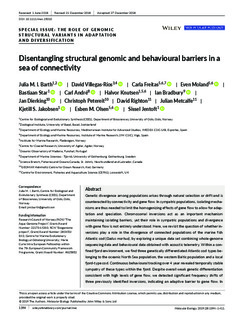| dc.contributor.author | Barth, Julia Maria Isis | |
| dc.contributor.author | Villegas-Ríos, David | |
| dc.contributor.author | Freitas, Carla | |
| dc.contributor.author | Moland, Even | |
| dc.contributor.author | Star, Bastiaan | |
| dc.contributor.author | André, Carl | |
| dc.contributor.author | Knutsen, Halvor | |
| dc.contributor.author | Bradbury, Ian | |
| dc.contributor.author | Dierking, Jan | |
| dc.contributor.author | Petereit, Christoph | |
| dc.contributor.author | Righton, David | |
| dc.contributor.author | Metcalfe, Julian | |
| dc.contributor.author | Jakobsen, Kjetill Sigurd | |
| dc.contributor.author | Olsen, Esben Moland | |
| dc.contributor.author | Jentoft, Sissel | |
| dc.date.accessioned | 2019-05-23T11:43:11Z | |
| dc.date.available | 2019-05-23T11:43:11Z | |
| dc.date.created | 2019-01-18T16:04:29Z | |
| dc.date.issued | 2019 | |
| dc.identifier.citation | Molecular Ecology. 2019, 28 (6), 1394-1411. | nb_NO |
| dc.identifier.issn | 0962-1083 | |
| dc.identifier.uri | http://hdl.handle.net/11250/2598563 | |
| dc.description.abstract | Genetic divergence among populations arises through natural selection or drift and is counteracted by connectivity and gene flow. In sympatric populations, isolating mechanisms are thus needed to limit the homogenizing effects of gene flow to allow for adaptation and speciation. Chromosomal inversions act as an important mechanism maintaining isolating barriers, yet their role in sympatric populations and divergence with gene flow is not entirely understood. Here, we revisit the question of whether inversions play a role in the divergence of connected populations of the marine fish Atlantic cod (Gadus morhua), by exploring a unique data set combining whole‐genome sequencing data and behavioural data obtained with acoustic telemetry. Within a confined fjord environment, we find three genetically differentiated Atlantic cod types belonging to the oceanic North Sea population, the western Baltic population and a local fjord‐type cod. Continuous behavioural tracking over 4 year revealed temporally stable sympatry of these types within the fjord. Despite overall weak genetic differentiation consistent with high levels of gene flow, we detected significant frequency shifts of three previously identified inversions, indicating an adaptive barrier to gene flow. In addition, behavioural data indicated that North Sea cod and individuals homozygous for the LG12 inversion had lower fitness in the fjord environment. However, North Sea and fjord‐type cod also occupy different depths, possibly contributing to prezygotic reproductive isolation and representing a behavioural barrier to gene flow. Our results provide the first insights into a complex interplay of genomic and behavioural isolating barriers in Atlantic cod and establish a new model system towards an understanding of the role of genomic structural variants in adaptation and diversification. | nb_NO |
| dc.language.iso | eng | nb_NO |
| dc.title | Disentangling structural genomic and behavioral barriers in a sea of connectivity | nb_NO |
| dc.type | Journal article | nb_NO |
| dc.type | Peer reviewed | nb_NO |
| dc.description.version | acceptedVersion | nb_NO |
| dc.description.version | publishedVersion | nb_NO |
| dc.source.pagenumber | 1394-1411 | nb_NO |
| dc.source.volume | 28 | nb_NO |
| dc.source.journal | Molecular Ecology | nb_NO |
| dc.source.issue | 6 | nb_NO |
| dc.identifier.doi | 10.1111/mec.15010 | |
| dc.identifier.cristin | 1660602 | |
| dc.relation.project | EC/FP7/625852 | nb_NO |
| dc.relation.project | Norges forskningsråd: 280453 | nb_NO |
| dc.relation.project | Norges forskningsråd: 221734 | nb_NO |
| cristin.unitcode | 7431,28,0,0 | |
| cristin.unitcode | 7431,23,0,0 | |
| cristin.unitname | Bunnsamfunn og kystinteraksjon | |
| cristin.unitname | Populasjonsgenetikk | |
| cristin.ispublished | true | |
| cristin.fulltext | postprint | |
| cristin.fulltext | original | |
| cristin.qualitycode | 2 | |

